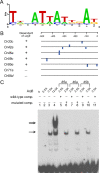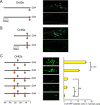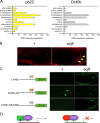Positive and negative regulation of odor receptor gene choice in Drosophila by acj6
- PMID: 19828808
- PMCID: PMC2782464
- DOI: 10.1523/JNEUROSCI.3525-09.2009
Positive and negative regulation of odor receptor gene choice in Drosophila by acj6
Abstract
Little is known about how individual olfactory receptor neurons (ORNs) select, from among many odor receptor genes, which genes to express. Abnormal chemosensory jump 6 (Acj6) is a POU domain transcription factor essential for the specification of ORN identity and odor receptor (Or) gene expression in the Drosophila maxillary palp, one of the two adult olfactory organs. However, the mechanism by which Acj6 functions in this process has not been investigated. Here, we systematically examine the role of Acj6 in the maxillary palp and in a major subset of antennal ORNs. We define an Acj6 binding site by a reiterative in vitro selection process. The site is found upstream of Or genes regulated by Acj6, and Acj6 binds to the site in Or promoters. Mutational analysis shows that the site is essential for Or regulation in vivo. Surprisingly, a novel ORN class in acj6 adults is found to arise from ectopic expression of a larval Or gene, which is repressed in wild type via an Acj6 binding site. Thus, Acj6 acts directly in the process of receptor gene choice; it plays a dual role, positive and negative, in the logic of the process, and acts in partitioning the larval and adult receptor repertoires.
Figures






References
-
- Ache BW, Young JM. Olfaction: diverse species, conserved principles. Neuron. 2005;48:417–430. - PubMed
-
- Certel SJ, Clyne PJ, Carlson JR, Johnson WA. Regulation of central neuron synaptic targeting by the Drosophila POU protein, Acj6. Development. 2000;127:2395–2405. - PubMed
-
- Clyne P, Grant A, O'Connell R, Carlson JR. Odorant response of individual sensilla on the Drosophila antenna. Invert Neurosci. 1997;3:127–135. - PubMed
-
- Clyne PJ, Warr CG, Freeman MR, Lessing D, Kim J, Carlson JR. A novel family of divergent seven-transmembrane proteins: candidate odorant receptors in Drosophila. Neuron. 1999a;22:327–338. - PubMed
-
- Clyne PJ, Certel SJ, de Bruyne M, Zaslavsky L, Johnson WA, Carlson JR. The odor specificities of a subset of olfactory receptor neurons are governed by Acj6, a POU-domain transcription factor. Neuron. 1999b;22:339–347. - PubMed
Publication types
MeSH terms
Substances
Grants and funding
LinkOut - more resources
Full Text Sources
Molecular Biology Databases
